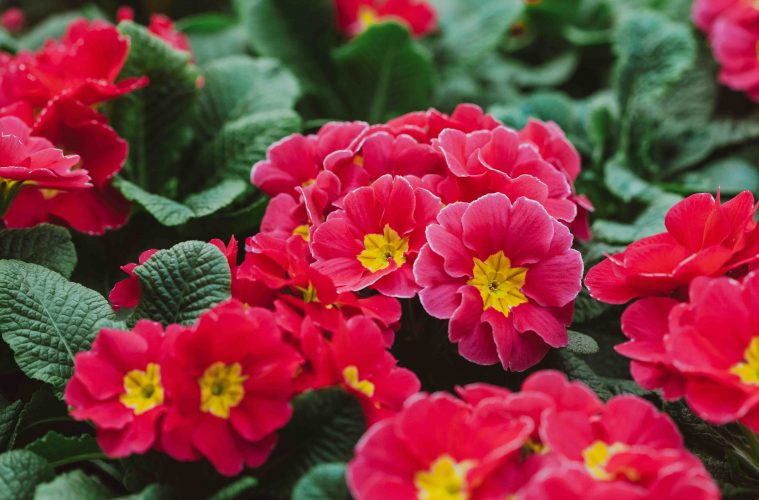For a pop of colour in a winter garden, you can’t beat the impact of annuals like primulas. The word Primula comes from the word Primus meaning ‘first’ as the flowers that are the first to appear in late winter or early spring.
Out of five hundred species in the Primula genus, there are three that are very popular as annuals in the garden, especially for cool season gardens:
- Fairy Primula (Primula malacoides) are the dainty flower primulas on tall stems in soft shades of pink and purple and then bright white, dark pink and crimson. They also have feathery leaves unlike the other primulas on this list.
- English Primrose (Primula acaulis) have a rosette of tongue-shaped leaves with large colourful blooms and bright yellow centres on single stalks. The flower colours range from vibrant dark purple, red, yellow, pink white and orange – all the colour you can possibly need in a garden or a container.
- German Primrose (Primula obconica) have slightly smaller blooms than P.acaulis and rouched rosettes of leaves. These are well-rounded plants in flower shades of purple, orange, pink and white.
ALSO SEE: HOW TO GROW CAULIFLOWER
How to grow primulas
Light
Primulas prefer a lightly shaded area for most of the day. In cooler regions they can tolerate full sun in winter going into spring, but in warmer areas they should be planted in more shade.
Soil
They do well in fertile, rich soil, but it also must be well draining. Add plenty of organic material like compost before planting and make sure the soil is loose and not too compacted.
Water
Primulas have their origins in boggy meadows. So, with this in mind know that they like water. Water regularly and don’t let them dry out.
Frost
They can tolerate a bit of mild frost but keep them well mulched and protected against severe frost.
Feeding
When the plants start to flower, feed them with a liquid fertiliser every couple of weeks.
Sowing Seed
We often see pictures of beautiful swathes of fairy primulas taking up large spaces of flower beds and wonder how we can get that too. Well, we can just by sowing some seed. Fairy primulas are available in seed form in all the various colours and will take from 14-21 days to germinate.
Steps
1. Fill a seedling stay with moist germinating mix.
2. Add a thin layer of vermiculite over the top.
3. Sow the seed very thinly over the top of the vermiculite and leave uncovered.
4. To water, either water from beneath by filling a tray with water and placing the seedling tray in the water letting it seep up to the top, or use a very fine mist spray bottle. The seed is very fine so you want to avoid any heavy watering that will wash the seeds into a corner or clump together.
5. Place another seed tray on top of the seeds to keep them safe. You can keep it in place with a stone. Don’t use plastic or glass as this creates heat build-up and primulas need the cold to germinate.
6. Place the tray in a cool shady place and check regularly to make sure they are watered.
7. After about 14-21 days you should have little seedlings, but make sure you get at least 4 leaves before planting out into the garden so that the root system is well formed.
8. Plant out 10-12 cm apart in the garden.
9. Feed with a liquid fertiliser as soon as the flower stalk appear and continue the feeding schedule every couple of weeks. You should get flowers in about 16 weeks from when you sowed the first seed.
ALSO SEE: 7 REASONS TO PLANT ORNAMENTAL KALE THIS WINTER

